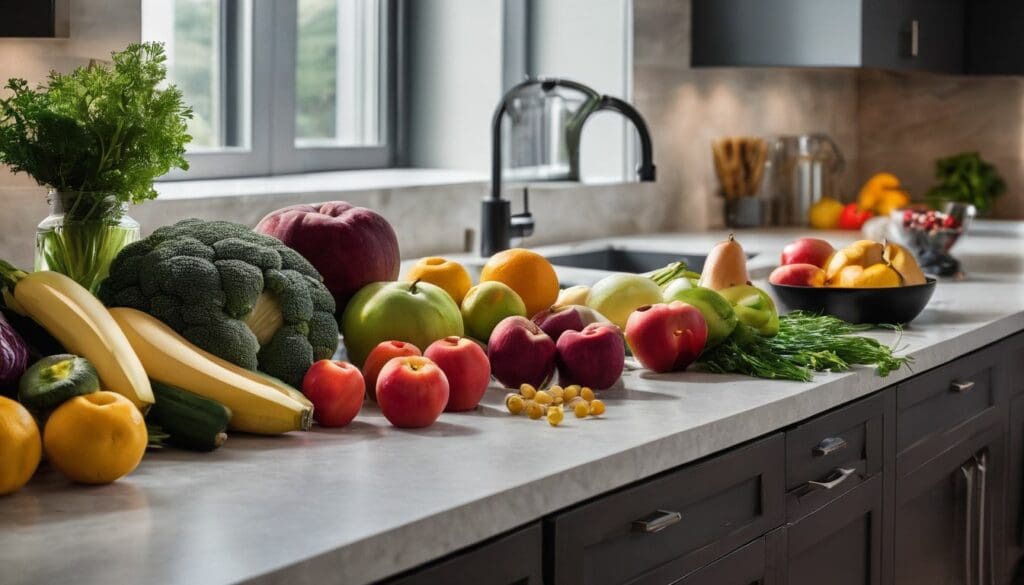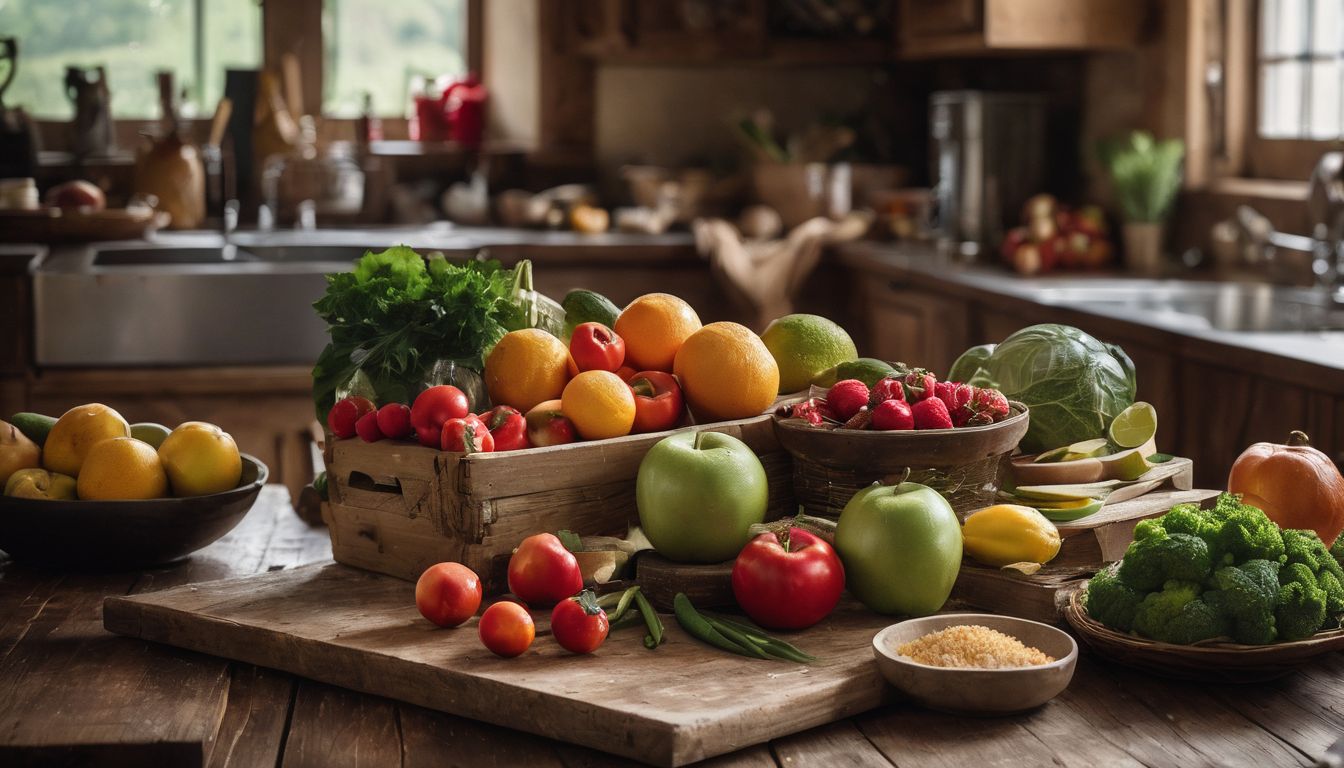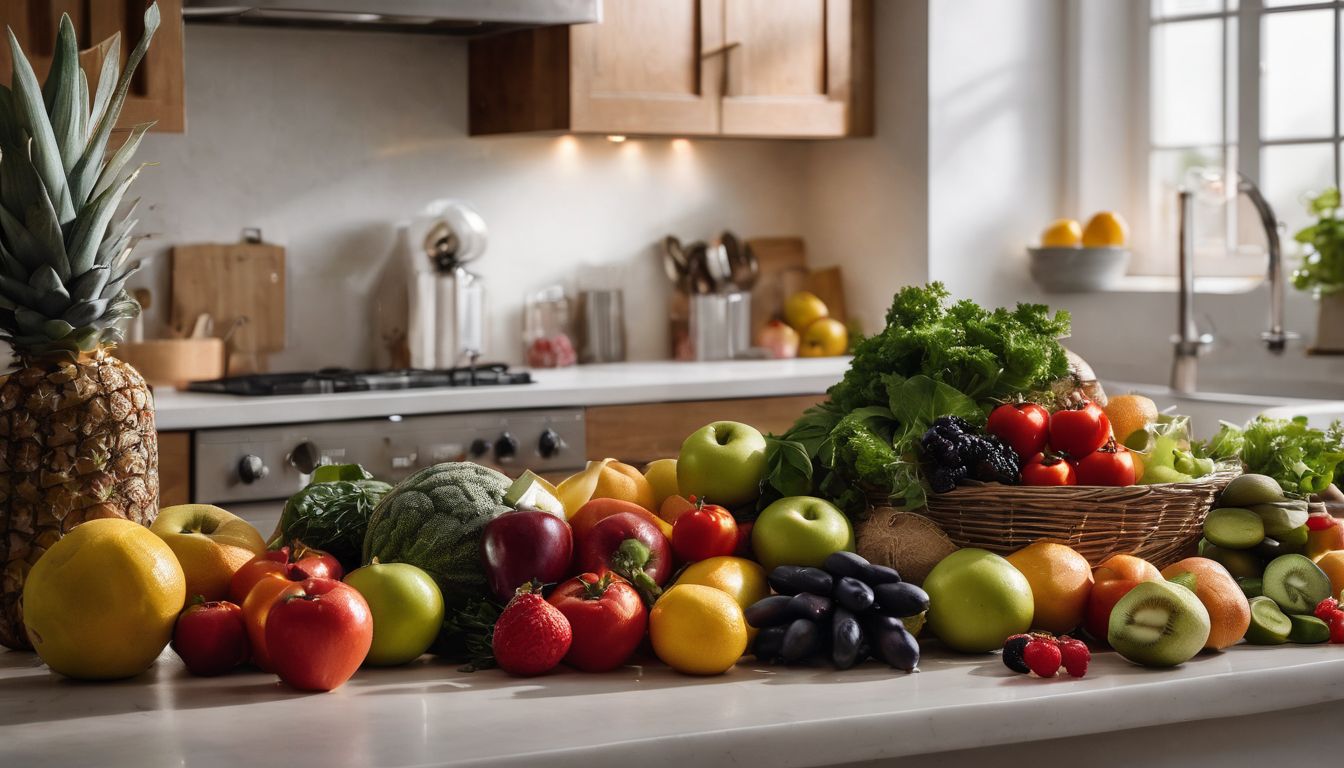Eating healthily without spending a fortune can seem like a puzzle. Did you know that by planning meals and shopping smartly, you could save money while eating well? This article is packed with tips and tricks to guide you through creating nutritious, budget-friendly meals with ease.
Dive in for savvy secrets to frugal feasting!
Key Takeaways
- Planning meals and creating a grocery list based on those plans helps avoid impulsive shopping, reducing waste and saving money.
- Buying whole foods such as fruits, vegetables, grains, and legumes instead of processed items cuts costs and supports environmental sustainability by decreasing packaging waste.
- Store brands typically offer the same nutritional quality as name brands but at a lower price point, making them a smart choice for budget-conscious shoppers.
- Growing your own produce can be cost-effective and environmentally friendly by lessening dependence on store-bought items that often involve transport and excessive packaging.
- Utilising coupons, sales discounts or deals from online retailers enables the purchase of healthy foods at reduced prices while still maintaining sustainable practices.
The Importance of Healthy Eating on a Budget
Balancing your finances doesn’t mean you have to compromise on the quality of your food. Healthy eating while sticking to a budget is both achievable and essential for maintaining our well-being.
It requires smart choices that not only ensure we get all the necessary nutrients but also help us avoid unnecessary waste, aligning with a conservation-focused lifestyle.
Investing in nutritious meals can save money in the long run by reducing health-related expenses caused by poor diets. Affordable diet tips include choosing whole foods over processed options, which pack more nutrition and are often less costly per serving.
This frugal approach supports both personal health and environmental sustainability, cutting down on packaging waste and energy spent on food processing. Making cost-effective dietary choices like these lays the foundation for a healthier life without breaking the bank.
Planning and Shopping for Healthy Meals on a Budget
Plan your meals in advance to avoid impulsive and expensive purchases. Stick to a grocery list and consider buying frozen or tinned foods, utilise coupons and sales, opt for store brands, and even grow your own produce for additional savings.
Plan your meals in advance
Prepare your meals in advance to save time and money. When you plan your meals ahead, you can make a grocery list and avoid unnecessary purchases. Utilise coupons and sales to save even more on your budget-friendly nutrition journey.
Consider growing your own produce for an eco-friendly approach to meal planning.
When you prepare meals in advance, stick to whole foods and buy seasonal produce for cost-effective dietary choices. Avoid wasting food by utilising leftovers creatively. Look for wallet-friendly healthy deals from online retailers to support conservation and environmental initiatives while saving money on low-budget wellness meals.
Stick to a grocery list
When shopping for groceries on a budget, sticking to a list is essential. It helps you stay focused and avoid impulsive purchases that can add up quickly. By planning your meals in advance and making a grocery list based on those meal plans, you can ensure that you only buy what you need, reducing food waste and saving money.
Additionally, it enables you to prioritise purchasing healthy and sustainable options while avoiding items with excessive packaging or environmentally harmful production methods.
Utilising your grocery list as a tool for mindful consumption not only supports your budget but also aligns with environmentally conscious values. It allows you to make intentional choices about the products you purchase, supporting conservation efforts by reducing unnecessary resource consumption and minimising food waste.
Buy frozen or tinned foods
When choosing groceries, consider purchasing frozen or tinned foods as an economical and sustainable option. These items are often more affordable than fresh produce and can be stored for a longer period, reducing food waste.
Opting for frozen or tinned fruits and vegetables also allows you to enjoy seasonal produce throughout the year, contributing to a more varied diet without breaking the budget. Additionally, canned fish such as tuna or salmon provide an inexpensive source of protein and omega-3 fatty acids.
By including frozen or tinned foods in your shopping list, you can support conservation efforts by minimising food spoilage and making budget-friendly choices that align with environmentally conscious practices.
Utilise coupons and sales
To further stretch your budget while shopping for healthy meals, be sure to utilise coupons and keep an eye out for sales. Many grocery stores offer discounts on organic and healthy options.
Prioritise purchasing items that are on sale or have a coupon available to reduce costs, allowing you to enjoy nutritious foods without breaking the bank. By making use of these money-saving opportunities, you can support conservation efforts by buying sustainably sourced food products while keeping your expenses in check.
When planning your meals and shopping list, incorporating available coupons and taking advantage of sales will contribute to both saving money and promoting environmental sustainability through mindful consumer choices.
Opt for store brands
After making the most of coupons and sales, consider choosing store brands to help you save money on your grocery bill while still enjoying high-quality products. Store brands are often more affordable than name-brand items, allowing you to stretch your budget further without compromising on taste or nutrition.
By opting for store brands, you can enjoy a wide range of healthy and nutritious options that are environmentally friendly and support sustainable food practices. These products provide an excellent way to maintain a balanced diet while being mindful of both your budget and the environment.
Choosing store brand items is a cost-effective way to stock up on essentials like grains, canned goods, dairy produce, and more – all without breaking the bank. Additionally, selecting store brands over name-brand foods can contribute towards reducing packaging waste and conserving environmental resources in line with your eco-friendly lifestyle goals.
Grow your own produce
Growing your own produce is a budget-friendly and environmentally sustainable way to access fresh, nutritious food. By cultivating your fruits and vegetables at home, you can reduce your reliance on store-bought produce and minimise the environmental impact of transportation and packaging.
Whether it’s a small herb garden on your windowsill or a backyard vegetable patch, growing your own produce allows you to enjoy the satisfaction of harvesting food while contributing to conservation efforts.
To get started with growing your own produce, consider planting low-maintenance herbs like basil, mint, or thyme in pots or using raised beds for larger crops such as tomatoes, peppers, and lettuce.
This hands-on approach not only promotes sustainability but also enables you to savour the taste of freshly picked ingredients in your meals. Embrace this rewarding experience that nurtures both personal health and environmental well-being.
Eating Healthy on a Budget: Not “One Size Fits All”
Healthy eating on a budget is not the same for everyone, so we’ll provide tips tailored to specific regions like Minnesota, Wisconsin and Iowa. Read more to find out how to eat healthy without breaking the bank!
Tips for specific regions (e.g. Minnesota, Wisconsin, Iowa)
When planning meals in the Midwest, consider these tips for healthy and budget-friendly eating:
- Embrace local produce from farmers’ markets to support your community and reduce environmental impact.
- Utilise regional staples like wild rice, cheese, and dairy as cost-effective ingredients in your meals.
- Take advantage of seasonal fish like walleye or trout for affordable and sustainable protein options.
Tips for Making Inexpensive and Nutritious Meals
Cook at home to control your ingredients and portion sizes. Purchase whole foods and buy in bulk to save money on nutritious options. Shopping for seasonal produce, utilising leftovers, and looking for deals from online retailers can also help you create affordable and nourishing meals.
Cook at home
Prepare your meals at home to reduce packaging waste and limit food miles. By cooking at home, you can control the ingredients, portion sizes and minimise food waste. Experiment with plant-based recipes that utilise affordable staples such as lentils, beans, and whole grains to create nourishing and eco-friendly dishes.
Embrace meal prepping to save time and reduce energy usage by planning ahead for multiple meals.
Choose nutrient-dense whole foods like fruits, vegetables, lean proteins, and healthy fats which are not only cost-effective but also support sustainable agriculture practices. When you cook at home using minimal processed foods or single-use plastics, it promotes a more environmentally friendly lifestyle while benefiting your health.
Buy whole foods
Purchase whole foods for maximum nutritional value and minimal environmental impact. Opt for fresh fruits, vegetables, grains, and legumes instead of processed or packaged options.
These nutrient-rich choices are often more affordable and contribute to a sustainable food system by reducing packaging waste and supporting local farmers. When selecting whole foods, choose seasonal produce that is abundant in your region to reduce transportation emissions and minimise the carbon footprint of your meals.
By purchasing whole foods, you can craft delicious, nutritious meals while minimising your environmental impact. This approach supports conservation efforts while also providing cost-effective and healthy dietary choices.
Buy in bulk
When purchasing food, consider buying in bulk to reduce packaging waste and lower overall costs. Look for whole grains, legumes, nuts, seeds, and dried fruits in larger quantities to save money and limit the amount of packaging used.
Buying in bulk allows you to measure out exactly what you need for recipes, reducing food waste while contributing to a more environmentally friendly lifestyle.
Moving forward to “Shop for seasonal produce,” which can offer cost-effective alternatives that benefit both your wallet and the environment.
Shop for seasonal produce
When shopping for seasonal produce, look for locally grown fruits and vegetables, as they are often fresher and more affordable. Seasonal produce is not only tastier but also packed with essential nutrients, making it a budget-friendly and healthy choice.
By opting for in-season fruits and veggies, you support local farmers while reducing the environmental impact of long-distance transportation.
Choosing seasonal produce allows individuals to embrace sustainable eating habits that benefit both their health and the environment. Additionally, by incorporating fresh seasonal ingredients into your meals, you can enjoy a variety of flavours throughout the year without breaking the bank.
Utilise leftovers
After shopping for seasonal produce, make the most of your purchases by utilising leftovers. Reduce food waste and save money by repurposing leftover vegetables, grains, and proteins into new meals.
Get creative in the kitchen and transform last night’s dinner into a delicious lunch or snack using simple recipes such as stir-fries, soups, or salads.
Maximise your grocery budget by incorporating leftovers into meal planning while promoting sustainable and eco-friendly practices. Embrace frugal eating without compromising on taste and nutrition with these practical tips for utilising leftovers effectively.
Find deals from online retailers
Get great deals on healthy and sustainable food options by checking out online retailers. Look for special offers, discounts, and bulk purchase options to save money while supporting environmentally friendly brands.
You can find budget-friendly organic produce, whole foods, and eco-friendly packaged items through various online platforms.
By taking advantage of the deals offered by online retailers, you can make cost-effective yet conscious choices that align with your values. Embrace the convenience and affordability of purchasing nutritious foods from these sources while contributing to environmental conservation efforts.
Conclusion
In conclusion, adopting healthy eating habits on a budget is achievable. Planning meals in advance and shopping wisely can save money. Utilising coupons and buying in bulk are also effective strategies for cost-effective nutrition.
Implementing these tips will not only benefit your health but also support conservation and environmental sustainability.
FAQs
1. What are some budget-friendly nutrition tips?
To enjoy economical healthy meals, focus on thrifty cooking and plan your meals around affordable ingredients that pack in nutrients.
2. Can I eat healthily without spending a lot of money?
Absolutely! By choosing low-cost nutrition options and making moneysaving food choices, you can maintain a budget-conscious diet.
3. How do I start economical meal planning?
Begin by creating a list of inexpensive nourishment items and design wallet-friendly healthy meals for the week to keep your costs down.
4. Are there tricks to make cost-effective dietary choices?
Yes, being budget-conscious when shopping and preparing food at home helps you stick to a low-budget wellness meal plan without sacrificing quality.
5. What’s the best way to save money while maintaining healthy eating habits?
Adopting thrifty meal planning strategies like buying in bulk, using leftovers creatively, and opting for seasonal produce supports moneysaving healthy eating.





